Find a Butterfly
Little Glassywing
Pompeius verna
Named
W.H. Edwards, 1862

Taxonomy & Nomenclature
Treated in the genus Polites in much of the literature.
Identification
Wingspan: 1 - 1 1/4". Both sexes dark blackish brown with forewings distinctly marked above and below. Most easily confused with females of Dun Skipper, Northern Broken Dash and other "black witches" but readily distinguished by comparing the forewing spots. In verna the spots are generally larger, whiter and more transparent. The largest (median) spot is particularly distinctive. In the male it is elongate and lies aslant bordering the prominent stigmal "brand"; its size and shape are in striking contrast to the wedged shaped sliver that lies just above it. In the female this spot is even more prominent and notably square or slightly rectangular; its translucent quality which inspired the species‘ common name, is apparent even with the naked eye. Another good field mark is the white end of the antennal stalk just below the club.
Distribution
North America from Minnesota south to east Texas east through southern Ontario to southern New England and northern Florida. Absent from most of Florida and Louisiana. In New England verna reaches only as far north as southern Vermont and New Hampshire.
Status in Massachusetts
Generally common to very common locally on milkweed or dogbane at the peak of its mid-summer flight period. Less common on Cape Cod and apparently absent from Nantucket and Martha‘s Vineyard (one unconfirmed anonymous record that was rejected by Jones (Kimball and Jones, 1943). The species seems to have undergone a notable change in status over the last century. Scudder (1889) regarded it as "everywhere exceedingly rare" and gives only three Massachusetts localities, all in the Connecticut Valley Maximum: 20 at Dartmouth (Bristol Co.), 3 July 1989.

Flight Period in Massachusetts
Last week in June through the third week in July, peaking in the first two weeks of July. Extreme Dates: 4 June 1987, Milford (Worcester Co.), R. Hildreth; 17 June 1988, Stockbridge (Berkshire Co.), E. Dunbar; 29 August 1992, Worcester, (Worcester Co.), T. Dodd.
Larval Food Plants
The only confirmed host species is the grass, Purpletop (Tridens flavus). This is a relatively uncommon and locally distributed plant in Massachusetts and since verna is common and widespread, it is likely that it utilizes other grasses as food plants here. However the North American range of T. flavus agrees closely with that of this butterfly.
Adult Food sources
The flight period of Little Glassy Wing coincides with the flowering of Common Milkweed, and plant and butterfly sometimes seem almost inseparable. However MBAP workers recorded nectaring from a total of 16 species of midsummer wildflowers, among which dogbane is another clear favorite. Males also drink at mud.

Habitat
Widely stated as moist sites including fields and bogs. This is not particularly apparent in Massachusetts, where dry fields with milkweed seem to be just as attractive. Verna‘s known food plant, Purpletop grass is an upland plant, often found along woodland edges.
Life Cycle
EGG: Pale greenish to white; a hemispherical dome, the surface appearing smooth (fine, reticulate microscupture). OVIPOSITION: No information. LARVA: yellow-green to brown covered with small dark brown dots with short brown hairs arising from each and with narrow blue-black stripes down the back and sides; head brown; constructs a silk-lined leaf roll; CHRYSALIS: A pale green cylinder with dark spots and dark areas near head and rear tip. OVERWINTERING STAGE: Chrysalis?
Account Author
Chris Leahy



